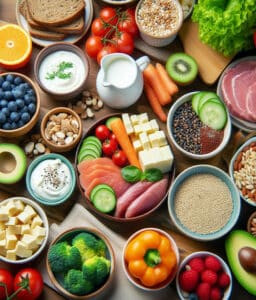Buckwheat and buckwheat diet
The buckwheat diet is one of the most popular mono diets. It is cheap and is considered very effective – it is promised that with its help you can “lose” from 2 to 9 kg of weight in 14 days.
All descriptions of this diet glorify buckwheat-they tell you how much benefit it has and how good it is for health.
Buckwheat is really good for your health.
But.
Does this mean that the buckwheat diet is also healthy?
What is buckwheat?
A bit of an odd question, isn’t it?
However, buckwheat is not a true cereal, but a pseudocereal – a seed that is used as a cereal grain but does not grow on grasses. Other common pseudocereal crops include quinoa and amaranth.
Buckwheat is processed into cereals, flour and noodles. Buckwheat is a key ingredient in many traditional European and Asian dishes.
Buckwheat does not contain gluten, so it is suitable for people with gluten intolerance.
Buckwheat is really a very healthy food because it is rich in minerals and antioxidants.
Buckwheat is mainly grown in Russia, Kazakhstan, China, Central and Eastern Europe.
Nutritional value of buckwheat
The nutritional value of buckwheat is much higher than that of many other cereals.
100 grams of raw buckwheat contains:
- Calories: 343
- Water: 10%
- Proteins: 13.2 g
- Carbohydrates: 71.5 g
- Sugar: 0 g
- Fiber: 10 g
- Fat: 3.4 g
Carbohydrates
In boiled buckwheat, about 20% of the weight is carbohydrates (in the form of starch).
Buckwheat has a glycaemic index (GI) from low to medium and therefore does not cause unhealthy spikes in blood sugar.
It has been proven that some soluble carbohydrates in buckwheat, such as fagopyritol and D-chiro-Inositol, help reduce blood sugar spikes.
Fiber
Fiber makes up 2.7% of the mass of boiled buckwheat (in the form of cellulose and lignin).
Fiber is not processed in our digestive tract, but it has a very significant impact on both our health and well-being (fiber is food for the intestinal microflora, on the “well-being” of which our immunity and intestinal health depend, which helps regulate sleep, appetite, mood …).
Protein
Buckwheat contains a small amount of protein – it makes up about 3.4% of the weight in boiled buckwheat groats.
However. thanks to the well-balanced amino acid profile, buckwheat proteins are of high quality. They are especially rich in the amino acids lysine and arginine.
On the other hand, the digestibility of buckwheat protein is relatively low due to the presence of anti-nutrients such as protease inhibitors and tannins.
Animal studies confirm that buckwheat protein can lower cholesterol levels in the blood, suppress the formation of gallstones and reduce the risk of colon cancer.
Buckwheat does not contain gluten – therefore, buckwheat products are suitable for people with gluten intolerance.
Vitamins and minerals
Buckwheat has more minerals than, for example, rice, wheat and corn, but it is low in vitamins.
Tartary buckwheat generally contains more nutrients than regular buckwheat.
The most common minerals contained in buckwheat are:
- Manganese – necessary for healthy metabolism, growth, development and antioxidant protection of the body;
- Copper is the most important trace element that can have a beneficial effect on heart health (when taken in small quantities);
- Magnesium – may reduce the risk of various chronic diseases, such as type 2 diabetes and heart disease;
- Iron. Iron deficiency causes anemia;
- Phosphorus. This mineral plays an important role in the growth and maintenance of body tissues.
The minerals in buckwheat are particularly well absorbed because, compared to other grains, buckwheat contains relatively little phytic acid (an inhibitor that interferes with the absorption of minerals).
Plant compounds
Buckwheat is rich in various plant compounds that have antioxidant properties, and buckwheat contains more of them than, for example, barley, oats, wheat and rye.
Tartary buckwheat has a higher antioxidant content than regular buckwheat.
The main plant compounds in buckwheat are:
- Rutin – can reduce the risk of cancer and improve inflammation, blood pressure and blood lipid profile;
- Quercetin – can have a beneficial effect on health, for example – reduce the risk of cancer and heart disease;
- Vitexin. Animal studies show that vitexin may improve health, but excessive intake may promote thyroid enlargement;
- D-chiro-inositol. This is a unique type of soluble carbohydrate that lowers blood sugar and can help with diabetes. Buckwheat is the richest source of this plant compound.
Buckwheat diet
Some authors include the buckwheat diet among detoxification diets. However, it more closely fits the definition of mono diets, as it replaces all other foods with buckwheat. Respectively – You can only eat buckwheat for breakfast, lunch and dinner.
It’s a pretty monotonous menu.
Although most people like buckwheat, eating only swollen buckwheat for a week or several weeks can be quite challenging.
It requires a lot of willpower, as well as good health because no matter how healthy buckwheat is, it does not contain everything that our body needs. The probability of experiencing a deficiency of some nutrients is quite high.
Maybe that’s why the buckwheat diet has 3 variations.
Buckwheat mono diet
This is the strictest type of buckwheat diet.
In most cases, the diet lasts one week, during which you can eat 200 grams of buckwheat daily without salt and spices, drink water, mineral water or green tea and, fortunately, also take vitamins.
The daily portion of buckwheat should be consumed in 3 to 4 meals, for example:
- 50 grams for breakfast;
- 100 grams for lunch;
- 50 grams for dinner.
Vegetables, fruits and other snacks are prohibited, as are freshly squeezed juices and other drinks.
It is also believed that buckwheat will be more beneficial if eaten not boiled but steamed or swollen (buckwheat is poured with boiling water and waited for 4 to 6 hours until it swells).
A variant of the buckwheat mono diet is also mentioned, where you can drink only water and eat only buckwheat, but in unlimited quantities.
Buckwheat and kefir diet
This diet option is a little less restrictive, as you can add kefir or low-fat yoghurt to buckwheat. Whether kefir improves the taste of swollen unsalted buckwheat is debatable, but at least the body gets a little more nutrients.
It goes without saying that buckwheat should be steamed or swollen by pouring kefir or yoghurt over it.
The amount of buckwheat does not change – 200 grams per day.
No products other than cereals and kefir are allowed.
The diet should be followed for one week.
Buckwheat and vegetable diet
In this version of the diet, buckwheat porridge makes up about 70 percent of the menu, and the remaining 30 percent are dried fruits, vegetables, boiled eggs or even lean meat.
This is the healthiest version of the buckwheat diet, because if you know what you are doing, you can, at least theoretically, provide yourself with everything your body needs.
But,
weight loss will be less because the amount of calories consumed is usually higher (compared to the buckwheat mono-diet and buckwheat-kefir diet).
Since this diet is not as radical as the two above-mentioned diet options, it is recommended to stick to it for two weeks.
Buckwheat and vegetable diet sample menu
Taking into account that buckwheat makes up 70 percent of the menu, the amount of buckwheat per day can be reduced from 200 to 150 grams, which should be eaten in 2 to 3 meals, compensating the remaining calories (about 170 Kcal) with other products.
The menu might look something like this:
- Breakfast – buckwheat + kefir or buckwheat + apple or boiled egg + apple or omelette (from 1 egg) + rosehip tea;
- Lunch – buckwheat + fish or buckwheat + steamed chicken fillet or buckwheat + vegetable salad or fish + vegetable salad;
- Snack – kefir or yoghurt or vegetable salad or dried fruit or apple or carrot;
- Dinner – buckwheat + apple or buckwheat + kefir or buckwheat (or rosehip) tea or boiled egg + vegetables.
There is a small variety -😊 However, it should be remembered that in addition to buckwheat, you can only take in about 170 calories per day, that is, the amount of additional food products is very limited.
For comparison:
- A medium-sized apple = around 100 Kcal;
- 100 g of chicken fillet = around 115 Kcal;
- 100 g of salmon = about 202 Kcal.
Buckwheat diet health effects
Any diet that excludes whole food groups can have a negative impact on health and the buckwheat diet is no exception.
The main problems are:
- Digestive disorders. Buckwheat contains a lot of fiber, which helps to activate peristalsis. However, in some cases, buckwheat can cause constipation;
- Loss of muscle mass (what slows down our metabolism). Eating only buckwheat causes the body to experience an acute protein and fat deficit and may begin to destroy muscle cells (the brain believes that muscles can be donated when energy or building material for other organs is needed);
- Nutrient deficiency. Although buckwheat contains some vitamins and minerals, a much wider range of vitamins and minerals is needed for daily needs. Therefore, the number of nutrients in the body will begin to run out, which will manifest itself as:
- Brittleness of nails and hair;
- Decreased immunity and libido;
- Deterioration of mood;
- Constant feeling of fatigue;
- …
You should definitely not even start thinking about the buckwheat diet if you have:
Gastrointestinal tract problems of any severity (gastritis, ulcers, etc.);
- Diabetes;
- Anemia;
- Depression;
- Great physical or psycho-emotional stress;
- You are pregnant or breastfeeding.
Key takeaways
Adhering to the buckwheat diet, you will almost certainly lose weight, but how much of this weight loss will fall on fat is a very big question.
Read more about body recomposition and how to evaluate your progress HERE.
Read more about the Yo-yo effect HERE.
Weight loss is caused not by any special properties or benefits of buckwheat, but by a decrease in the number of calories consumed due to poor nutrition. Thus, the lost kilograms are very likely to return, perhaps even in larger quantities.
Buckwheat as a food product is undoubtedly very healthy, but this does not mean that the buckwheat diet is also healthy and that we can be healthy and full of energy by eating only buckwheat.
Despite buckwheat being rich in minerals, it does not contain fats and proteins in the amount necessary for the normal functioning of the body.
The longer we torture ourselves with this diet, the greater the risk of nutrient deficiency.
If you still want to try this diet, do not follow it for more than one week. If you follow it for longer, the risk of nutrient deficiency will increase significantly.
I would say that anyone who recommends a buckwheat diet to you as healthy should be ignored in all matters related to health, diets and medicine from now on.
Eat tasty, eat balanced and be healthy!
Phytochemicals and biofunctional properties of buckwheat
Minerals, phytic acid, tannin and rutin in buckwheat seed milling fractions
Resistant Starch Formation Following Autoclaving of Buckwheat (Fagopyrum esculentum Moench) Groats.
Intestinal health functions of colonic microbial metabolites
A review of the potential mechanisms for the lowering of colorectal oncogenesis by butyrate
Butyrate: implications for intestinal function
Tartary Buckwheat in Human Nutrition
Composition and technological properties of the flour and bran from common and tartary buckwheat
Cardiovascular disease from copper deficiency
Suboptimal magnesium status in the United States: are the health consequences underestimated?
Buckwheat—the source of antioxidant activity in functional foods
Tartary buckwheat (Fagopyrum tataricum Gaertn.) as a source of dietary rutin and quercitrin
Therapeutic potential of quercetin to decrease blood pressure: review of efficacy and mechanisms
Antithyroid effects in vivo and in vitro of vitexin: a C-glucosylflavone in millet
Review of the effects of vitexin in oxidative stress‐related diseases
Buckwheat concentrate reduces serum glucose in streptozotocin-diabetic rats

Help to maintain this site, create interesting articles and delicious low-calorie recipes!
Share this article
Follow me on Facebook
I recommend reading these articles as well


What are macronutrients and what are micronutrients?
How does counting macronutrients help you live a healthy life? And what is the difference between macronutrients and micronutrients?

How to lose weight after 50, 60 ...?
Why losing weight after 50 is harder and the 13 best ways to lose weight after 50.

Which oil is better for frying, and which for salads?
How to choose the healthiest and most suitable oil for the specific type of cooking. Why may frying oil not be suitable for sauces or salads?

